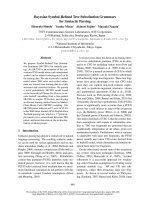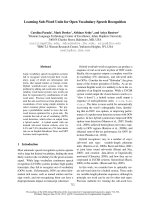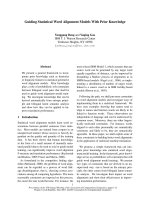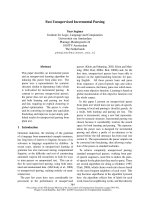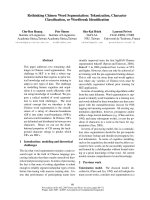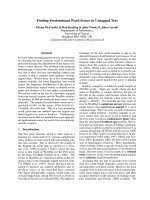Báo cáo khoa học: "Bayesian Unsupervised Word Segmentation with Nested Pitman-Yor Language Modeling" doc
Bạn đang xem bản rút gọn của tài liệu. Xem và tải ngay bản đầy đủ của tài liệu tại đây (320.25 KB, 9 trang )
Proceedings of the 47th Annual Meeting of the ACL and the 4th IJCNLP of the AFNLP, pages 100–108,
Suntec, Singapore, 2-7 August 2009.
c
2009 ACL and AFNLP
Bayesian Unsupervised Word Segmentation with
Nested Pitman-Yor Language Modeling
Daichi Mochihashi Takeshi Yamada Naonori Ueda
NTT Communication Science Laboratories
Hikaridai 2-4, Keihanna Science City, Kyoto, Japan
{daichi,yamada,ueda}@cslab.kecl.ntt.co.jp
Abstract
In this paper, we propose a new Bayesian
model for fully unsupervised word seg-
mentation and an efficient blocked Gibbs
sampler combined with dynamic program-
ming for inference. Our model is a nested
hierarchical Pitman-Yor language model,
where Pitman-Yor spelling model is em-
bedded in the word model. We confirmed
that it significantly outperforms previous
reported results in both phonetic tran-
scripts and standard datasets for Chinese
and Japanese word segmentation. Our
model is also considered as a way to con-
struct an accurate word n-gram language
model directly from characters of arbitrary
language, without any “word” indications.
1 Introduction
“Word” is no trivial concept in many languages.
Asian languages such as Chinese and Japanese
have no explicit word boundaries, thus word seg-
mentation is a crucial first step when processing
them. Even in western languages, valid “words”
are often not identical to space-separated tokens.
For example, proper nouns such as “United King-
dom” or idiomatic phrases such as “with respect
to” actually function as a single word, and we of-
ten condense them into the virtual words “UK”
and “w.r.t.”.
In order to extract “words” from text streams,
unsupervised word segmentation is an important
research area because the criteria for creating su-
pervised training data could be arbitrary, and will
be suboptimal for applications that rely on seg-
mentations. It is particularly difficult to create
“correct” training data for speech transcripts, col-
loquial texts, and classics where segmentations are
often ambiguous, let alone is impossible for un-
known languages whose properties computational
linguists might seek to uncover.
From a scientific point of view, it is also inter-
esting because it can shed light on how children
learn “words” without the explicitly given bound-
aries for every word, which is assumed by super-
vised learning approaches.
Lately, model-based methods have been intro-
duced for unsupervised segmentation, in particu-
lar those based on Dirichlet processes on words
(Goldwater et al., 2006; Xu et al., 2008). This
maximizes the probability of word segmentation
w given a string s :
ˆ
w = argmax
w
p(w|s) . (1)
This approach often implicitly includes heuristic
criteria proposed so far
1
, while having a clear sta-
tistical semantics to find the most probable word
segmentation that will maximize the probability of
the data, here the strings.
However, they are still na¨ıve with respect to
word spellings, and the inference is very slow ow-
ing to inefficient Gibbs sampling. Crucially, since
they rely on sampling a word boundary between
two neighboring words, they can leverage only up
to bigram word dependencies.
In this paper, we extend this work to pro-
pose a more efficient and accurate unsupervised
word segmentation that will optimize the per-
formance of the word n-gram Pitman-Yor (i.e.
Bayesian Kneser-Ney) language model, with an
accurate character ∞-gram Pitman-Yor spelling
model embedded in word models. Further-
more, it can be viewed as a method for building
a high-performance n-gram language model di-
rectly from character strings of arbitrary language.
It is carefully smoothed and has no “unknown
words” problem, resulting from its model struc-
ture.
This paper is organized as follows. In Section 2,
1
For instance, TANGO algorithm (Ando and Lee, 2003)
essentially finds segments such that character n-gram proba-
bilities are maximized blockwise, averaged over n.
100
(a) Generating n-gram distributions G hierarchically
from the Pitman-Yor process. Here, n = 3.
(b) Equivalent representation using a hierarchical Chinese
Restaurant process. Each word in a training text is a “customer”
shown in italic, and added to the leaf of its two words context.
Figure 1: Hierarchical Pitman-Yor Language Model.
we briefly describe a language model based on the
Pitman-Yor process (Teh, 2006b), which is a gen-
eralization of the Dirichlet process used in previ-
ous research. By embedding a character n-gram
in word n-gram from a Bayesian perspective, Sec-
tion 3 introduces a novel language model for word
segmentation, which we call the Nested Pitman-
Yor language model. Section 4 describes an ef-
ficient blocked Gibbs sampler that leverages dy-
namic programming for inference. In Section 5 we
describe experiments on the standard datasets in
Chinese and Japanese in addition to English pho-
netic transcripts, and semi-supervised experiments
are also explored. Section 6 is a discussion and
Section 7 concludes the paper.
2 Pitman-Yor process and n-gram
models
To compute a probability p(w|s) in (1), we adopt
a Bayesian language model lately proposed by
(Teh, 2006b; Goldwater et al., 2005) based on
the Pitman-Yor process, a generalization of the
Dirichlet process. As we shall see, this is a
Bayesian theory of the best-performing Kneser-
Ney smoothing of n-grams (Kneser and Ney,
1995), allowing an integrated modeling from a
Bayesian perspective as persued in this paper.
The Pitman-Yor (PY) process is a stochastic
process that generates discrete probability distri-
bution G that is similar to another distribution G
0
,
called a base measure. It is written as
G ∼ PY(G
0
, d,θ) , (2)
where d is a discount factor and θ controls how
similar G is to G
0
on average.
Suppose we have a unigram word distribution
G
1
={ p(·) } where · ranges over each word in the
lexicon. The bigram distribution G
2
= { p(·|v) }
given a word v is different from G
1
, but will be
similar to G
1
especially for high frequency words.
Therefore, we can generate G
2
from a PY pro-
cess of base measure G
1
, as G
2
∼ PY(G
1
, d, θ).
Similarly, trigram distribution G
3
= { p(·|v
v) }
given an additional word v
is generated as G
3
∼
PY(G
2
, d, θ), and G
1
, G
2
, G
3
will form a tree
structure shown in Figure 1(a).
In practice, we cannot observe G directly be-
cause it will be infinite dimensional distribution
over the possible words, as we shall see in this
paper. However, when we integrate out G it is
known that Figure 1(a) can be represented by an
equivalent hierarchical Chinese Restaurant Pro-
cess (CRP) (Aldous, 1985) as in Figure 1(b).
In this representation, each n-gram context h
(including the null context for unigrams) is
a Chinese restaurant whose customers are the
n-gram counts c(w|h) seated over the tables
1 · · · t
hw
. The seatings has been incrementally
constructed by choosing the table k for each count
in c(w|h) with probability proportional to
c
hwk
− d (k = 1, · · · , t
hw
)
θ + d·t
h·
(k = new ) ,
(3)
where c
hwk
is the number of customers seated at
table k thus far and t
h·
=
w
t
hw
is the total num-
ber of tables in h. When k = new is selected,
t
hw
is incremented, and this means that the count
was actually generated from the shorter context h
.
Therefore, in that case a proxy customer is sent to
the parent restaurant and this process will recurse.
For example, if we have a sentence “she will
sing” in the training data for trigrams, we add each
word “she” “will” “sing” “$” as a customer to its
two preceding words context node, as described
in Figure 1(b). Here, “$” is a special token rep-
resenting a sentence boundary in language model-
101
ing (Brown et al., 1992).
As a result, the n-gram probability of this hier-
archical Pitman-Yor language model (HPYLM) is
recursively computed as
p(w|h) =
c(w|h)−d·t
hw
θ+c(h)
+
θ+d·t
h·
θ+c(h)
p(w|h
),
(4)
where p(w|h
) is the same probability using a
(n−1)-gram context h
. When we set t
hw
≡ 1, (4)
recovers a Kneser-Ney smoothing: thus a HPYLM
is a Bayesian Kneser-Ney language model as well
as an extension of the hierarchical Dirichlet Pro-
cess (HDP) used in Goldwater et al. (2006). θ, d
are hyperparameters that can be learned as Gamma
and Beta posteriors, respectively, given the data.
For details, see Teh (2006a).
The inference of this model interleaves adding
and removing a customer to optimize t
hw
, d, and
θ using MCMC. However, in our case “words”
are not known a priori: the next section describes
how to accomplish this by constructing a nested
HPYLM of words and characters, with the associ-
ated inference algorithm.
3 Nested Pitman-Yor Language Model
Thus far we have assumed that the unigram G
1
is already given, but of course it should also be
generated as G
1
∼ PY(G
0
, d, θ).
Here, a problem occurs: What should we use for
G
0
, namely the prior probabilities over words
2
?
If a lexicon is finite, we can use a uniform prior
G
0
(w) = 1/|V | for every word w in lexicon V .
However, with word segmentation every substring
could be a word, thus the lexicon is not limited but
will be countably infinite.
Building an accurate G
0
is crucial for word
segmentation, since it determines how the possi-
ble words will look like. Previous work using a
Dirichlet process used a relatively simple prior for
G
0
, namely an uniform distribution over charac-
ters (Goldwater et al., 2006), or a prior solely de-
pendent on word length with a Poisson distribution
whose parameter is fixed by hand (Xu et al., 2008).
In contrast, in this paper we use a simple but
more elaborate model, that is, a character n-gram
language model that also employs HPYLM. This
is important because in English, for example,
words are likely to end in ‘–tion’ and begin with
2
Note that this is different from unigrams, which are pos-
terior distribution given data.
Figure 2: Chinese restaurant representation of our
Nested Pitman-Yor Language Model (NPYLM).
‘re–’, but almost never end in ‘–tio’ nor begin with
‘sre–’
3
.
Therefore, we use
G
0
(w) = p(c
1
· · · c
k
) (5)
=
k
i=1
p(c
i
|c
1
· · · c
i−1
) (6)
where string c
1
· · · c
k
is a spelling of w, and
p(c
i
|c
1
· · · c
i−1
) is given by the character HPYLM
according to (4).
This language model, which we call Nested
Pitman-Yor Language Model (NPYLM) hereafter,
is the hierarchical language model shown in Fig-
ure 2, where the character HPYLM is embedded
as a base measure of the word HPYLM.
4
As the
final base measure for the character HPYLM, we
used a uniform prior over the possible characters
of a given language. To avoid dependency on n-
gram order n, we actually used the ∞-gram lan-
guage model (Mochihashi and Sumita, 2007), a
variable order HPYLM, for characters. However,
for generality we hereafter state that we used the
HPYLM. The theory remains the same for ∞-
grams, except sampling or marginalizing over n
as needed.
Furthermore, we corrected (5) so that word
length will have a Poisson distribution whose pa-
rameter can now be estimated for a given language
and word type. We describe this in detail in Sec-
tion 4.3.
Chinese Restaurant Representation
In our NPYLM, the word model and the charac-
ter model are not separate but connected through
a nested CRP. When a word w is generated from
its parent at the unigram node, it means that w
3
Imagine we try to segment an English character string
“itisre
cognizedasthe· · · .”
4
Strictly speaking, this is not “nested” in the sense of a
Nested Dirichlet process (Rodriguez et al., 2008) and could
be called “hierarchical HPYLM”, which denotes another
model for domain adaptation (Wood and Teh, 2008).
102
is drawn from the base measure, namely a char-
acter HPYLM. Then we divide w into characters
c
1
· · · c
k
to yield a “sentence” of characters and
feed this into the character HPYLM as data.
Conversely, when a table becomes empty, this
means that the data associated with the table are
no longer valid. Therefore we remove the corre-
sponding customers from the character HPYLM
using the inverse procedure of adding a customer
in Section 2.
All these processes will be invoked when a
string is segmented into “words” and customers
are added to the leaves of the word HPYLM. To
segment a string into “words”, we used efficient
dynamic programming combined with MCMC, as
described in the next section.
4 Inference
To find the hidden word segmentation w of a string
s = c
1
· · · c
N
, which is equivalent to the vector of
binary hidden variables z = z
1
· · · z
N
, the sim-
plest approach is to build a Gibbs sampler that ran-
domly selects a character c
i
and draw a binary de-
cision z
i
as to whether there is a word boundary,
and then update the language model according to
the new segmentation (Goldwater et al., 2006; Xu
et al., 2008). When we iterate this procedure suf-
ficiently long, it becomes a sample from the true
distribution (1) (Gilks et al., 1996).
However, this sampler is too inefficient since
time series data such as word segmentation have a
very high correlation between neighboring words.
As a result, the sampler is extremely slow to con-
verge. In fact, (Goldwater et al., 2006) reports that
the sampler would not mix without annealing, and
the experiments needed 20,000 times of sampling
for every character in the training data.
Furthermore, it has an inherent limitation that
it cannot deal with larger than bigrams, because it
uses only local statistics between directly contigu-
ous words for word segmentation.
4.1 Blocked Gibbs sampler
Instead, we propose a sentence-wise Gibbs sam-
pler of word segmentation using efficient dynamic
programming, as shown in Figure 3.
In this algorithm, first we randomly select a
string, and then remove the “sentence” data of its
word segmentation from the NPYLM. Sampling
a new segmentation, we update the NPYLM by
adding a new “sentence” according to the new seg-
1: for j = 1 · · · J do
2: for s in randperm (s
1
, · · · , s
D
) do
3: if j >1 then
4: Remove customers of w(s) from Θ
5: end if
6: Draw w(s) according to p(w|s, Θ)
7: Add customers of w(s) to Θ
8: end for
9: Sample hyperparameters of Θ
10: end for
Figure 3: Blocked Gibbs Sampler of NPYLM Θ.
mentation. When we repeat this process, it is ex-
pected to mix rapidly because it implicitly consid-
ers all possible segmentations of the given string
at the same time.
This is called a blocked Gibbs sampler that sam-
ples z block-wise for each sentence. It has an ad-
ditional advantage in that we can accommodate
higher-order relationships than bigrams, particu-
larly trigrams, for word segmentation.
5
4.2 Forward-Backward inference
Then, how can we sample a segmentation w for
each string s? In accordance with the Forward fil-
tering Backward sampling of HMM (Scott, 2002),
this is achieved by essentially the same algorithm
employed to sample a PCFG parse tree within
MCMC (Johnson et al., 2007) and grammar-based
segmentation (Johnson and Goldwater, 2009).
Forward Filtering. For this purpose, we main-
tain a forward variable α[t][k] in the bigram case.
α[t][k] is the probability of a string c
1
· · · c
t
with
the final k characters being a word (see Figure 4).
Segmentations before the final k characters are
marginalized using the following recursive rela-
tionship:
α[t][k] =
t−k
j=1
p(c
t
t−k+1
|c
t−k
t−k−j+1
)·α[t−k][j] (7)
where α[0][0] = 1 and we wrote c
n
· · · c
m
as c
m
n
.
6
The rationale for (7) is as follows. Since main-
taining binary variables z
1
, · · · , z
N
is equivalent
to maintaining a distance to the nearest backward
5
In principle fourgrams or beyond are also possible, but
will be too complex while the gain will be small. For this
purpose, Particle MCMC (Doucet et al., 2009) is promising
but less efficient in a preliminary experiment.
6
As Murphy (2002) noted, in semi-HMM we cannot use a
standard trick to avoid underflow by normalizing α[t][k] into
p(k|t), since the model is asynchronous. Instead we always
compute (7) using logsumexp().
103
Figure 4: Forward filtering of α[t][k] to marginal-
ize out possible segmentations j before t−k.
1: for t = 1 to N do
2: for k = max(1, t−L) to t do
3: Compute α[t][k] according to (7).
4: end for
5: end for
6: Initialize t ← N, i ← 0, w
0
← $
7: while t > 0 do
8: Draw k ∝ p(w
i
|c
t
t−k+1
, Θ) · α[t][k]
9: Set w
i
← c
t
t−k+1
10: Set t ← t − k, i ← i + 1
11: end while
12: Return w = w
i
, w
i−1
, · · · , w
1
.
Figure 5: Forward-Backward sampling of word
segmentation w. (in bigram case)
word boundary for each t as q
t
, we can write
α[t][k] =p(c
t
1
, q
t
=k) (8)
=
j
p(c
t
1
, q
t
=k, q
t−k
=j) (9)
=
j
p(c
t−k
1
, c
t
t−k+1
, q
t
=k, q
t−k
=j)(10)
=
j
p(c
t
t−k+1
|c
t−k
1
)p(c
t−k
1
, q
t−k
=j)(11)
=
j
p(c
t
t−k+1
|c
t−k
1
)α[t−k][j] , (12)
where we used conditional independency of q
t
given q
t−k
and uniform prior over q
t
in (11) above.
Backward Sampling. Once the probability ta-
ble α[t][k] is obtained, we can sample a word seg-
mentation backwards. Since α[N ][k] is a marginal
probability of string c
N
1
with the last k charac-
ters being a word, and there is always a sentence
boundary token $ at the end of the string, with
probability proportional to p($|c
N
N−k
)·α[N][k] we
can sample k to choose the boundary of the final
word. The second final word is similarly sampled
using the probability of preceding the last word
just sampled: we continue this process until we
arrive at the beginning of the string (Figure 5).
Trigram case. For simplicity, we showed the
algorithm for bigrams above. For trigrams, we
maintain a forward variable α[t][k][j], which rep-
resents a marginal probability of string c
1
· · · c
t
with both the final k characters and further j
characters preceding it being words. Forward-
Backward algorithm becomes complicated thus
omitted, but can be derived following the extended
algorithm for second order HMM (He, 1988).
Complexity This algorithm has a complexity of
O(NL
2
) for bigrams and O(NL
3
) for trigrams
for each sentence, where N is the length of the
sentence and L is the maximum allowed length of
a word (≤ N).
4.3 Poisson correction
As Nagata (1996) noted, when only (5) is used in-
adequately low probabilities are assigned to long
words, because it has a largely exponential dis-
tribution over length. To correct this, we assume
that word length k has a Poisson distribution with
a mean λ:
Po(k|λ) = e
−λ
λ
k
k!
. (13)
Since the appearance of c
1
· · · c
k
is equivalent
to that of length k and the content, by making the
character n-gram model explicit as Θ we can set
p(c
1
· · · c
k
) = p(c
1
· · · c
k
, k) (14)
=
p(c
1
· · · c
k
, k|Θ)
p(k|Θ)
Po(k|λ) (15)
where p(c
1
· · · c
k
, k|Θ) is an n-gram probabil-
ity given by (6), and p(k|Θ) is a probability
that a word of length k will be generated from
Θ. While previous work used p(k|Θ) = (1 −
p($))
k−1
p($), this is only true for unigrams. In-
stead, we employed a Monte Carlo method that
generates words randomly from Θ to obtain the
empirical estimates of p(k|Θ).
Estimating λ. Of course, we do not leave λ as a
constant. Instead, we put a Gamma distribution
p(λ) = Ga(a, b) =
b
a
Γ(a)
λ
a−1
e
−bλ
(16)
to estimate λ from the data for given language
and word type.
7
Here, Γ(x) is a Gamma function
and a, b are the hyperparameters chosen to give a
nearly uniform prior distribution.
8
7
We used different λ for different word types, such as dig-
its, alphabets, hiragana, CJK characters, and their mixtures.
W is a set of words of each such type, and (13) becomes a
mixture of Poisson distributions in this case.
8
In the following experiments, we set a= 0.2, b =0.1.
104
Denoting W as a set of “words” obtained from
word segmentation, the posterior distribution of λ
used for (13) is
p(λ|W ) ∝ p(W |λ)p(λ)
= Ga
a+
w∈W
t(w)|w|, b+
w∈W
t(w)
, (17)
where t(w) is the number of times word w is gen-
erated from the character HPYLM, i.e. the number
of tables t
w
for w in word unigrams. We sampled
λ from this posterior for each Gibbs iteration.
5 Experiments
To validate our model, we conducted experiments
on standard datasets for Chinese and Japanese
word segmentation that are publicly available, as
well as the same dataset used in (Goldwater et al.,
2006). Note that NPYLM maximizes the probabil-
ity of strings, equivalently, minimizes the perplex-
ity per character. Therefore, the recovery of the
“ground truth” that is not available for inference is
a byproduct in unsupervised learning.
Since our implementation is based on Unicode
and learns all hyperparameters from the data, we
also confirmed that NPYLM segments the Arabic
Gigawords equally well.
5.1 English phonetic transcripts
In order to directly compare with the previously
reported result, we first used the same dataset
as Goldwater et al. (2006). This dataset con-
sists of 9,790 English phonetic transcripts from
CHILDES data (MacWhinney and Snow, 1985).
Since our algorithm converges rather fast, we
ran the Gibbs sampler of trigram NPYLM for 200
iterations to obtain the results in Table 1. Among
the token precision (P), recall (R), and F-measure
(F), the recall is especially higher to outperform
the previous result based on HDP in F-measure.
Meanwhile, the same measures over the obtained
lexicon (LP, LR, LF) are not always improved.
Moreover, the average length of words inferred
was surprisingly similar to ground truth: 2.88,
while the ground truth is 2.87.
Table 2 shows the empirical computational time
needed to obtain these results. Although the con-
vergence in MCMC is not uniquely identified, im-
provement in efficiency is also outstanding.
5.2 Chinese and Japanese word segmentation
To show applicability beyond small phonetic tran-
scripts, we used standard datasets for Chinese and
Model P R F LP LR LF
NPY(3) 74.8 75.2 75.0 47.8 59.7 53.1
NPY(2) 74.8 76.7 75.7 57.3 56.6 57.0
HDP(2) 75.2 69.6 72.3 63.5 55.2 59.1
Table 1: Segmentation accuracies on English pho-
netic transcripts. NPY(n) means n-gram NPYLM.
Results for HDP(2) are taken from Goldwater et
al. (2009), which corrects the errors in Goldwater
et al. (2006).
Model time iterations
NPYLM 17min 200
HDP 10h 55min 20000
Table 2: Computations needed for Table 1. Itera-
tions for “HDP” is the same as described in Gold-
water et al. (2009). Actually, NPYLM approxi-
mately converged around 50 iterations, 4 minutes.
Japanese word segmentation, with all supervised
segmentations removed in advance.
Chinese For Chinese, we used a publicly avail-
able SIGHAN Bakeoff 2005 dataset (Emerson,
2005). To compare with the latest unsupervised
results (using a closed dataset of Bakeoff 2006),
we chose the common sets prepared by Microsoft
Research Asia (MSR) for simplified Chinese, and
by City University of Hong Kong (CITYU) for
traditional Chinese. We used a random subset of
50,000 sentences from each dataset for training,
and the evaluation was conducted on the enclosed
test data.
9
Japanese For Japanese, we used the Kyoto Cor-
pus (Kyoto) (Kurohashi and Nagao, 1998): we
used random subset of 1,000 sentences for evalua-
tion and the remaining 37,400 sentences for train-
ing. In all cases we removed all whitespaces to
yield raw character strings for inference, and set
L = 4 for Chinese and L = 8 for Japanese to run
the Gibbs sampler for 400 iterations.
The results (in token F-measures) are shown in
Table 3. Our NPYLM significantly ourperforms
the best results using a heuristic approach reported
in Zhao and Kit (2008). While Japanese accura-
cies appear lower, subjective qualities are much
higher. This is mostly because NPYLM segments
inflectional suffixes and combines frequent proper
names, which are inconsistent with the “correct”
9
Notice that analyzing a test data is not easy for character-
wise Gibbs sampler of previous work. Meanwhile, NPYLM
easily finds the best segmentation using the Viterbi algorithm
once the model is learned.
105
Model MSR CITYU Kyoto
NPY(2) 80.2 (51.9) 82.4 (126.5) 62.1 (23.1)
NPY(3) 80.7 (48.8) 81.7 (128.3) 66.6 (20.6)
ZK08 66.7 (—) 69.2 (—) —
Table 3: Accuracies and perplexities per character
(in parentheses) on actual corpora. “ZK08” are the
best results reported in Zhao and Kit (2008). We
used ∞-gram for characters.
MSR CITYU Kyoto
Semi 0.895 (48.8) 0.898 (124.7) 0.913 (20.3)
Sup 0.945 (81.4) 0.941 (194.8) 0.971 (21.3)
Table 4: Semi-supervised and supervised results.
Semi-supervised results used only 10K sentences
(1/5) of supervised segmentations.
segmentations. Bigram and trigram performances
are similar for Chinese, but trigram performs bet-
ter for Japanese. In fact, although the difference
in perplexity per character is not so large, the per-
plexity per word is radically reduced: 439.8 (bi-
gram) to 190.1 (trigram). This is because trigram
models can leverage complex dependencies over
words to yield shorter words, resulting in better
predictions and increased tokens.
Furthermore, NPYLM is easily amenable to
semi-supervised or even supervised learning. In
that case, we have only to replace the word seg-
mentation w(s) in Figure 3 to the supervised one,
for all or part of the training data. Table 4
shows the results using 10,000 sentences (1/5) or
complete supervision. Our completely generative
model achieves the performance of 94% (Chinese)
or even 97% (Japanese) in supervised case. The
result also shows that the supervised segmenta-
tions are suboptimal with respect to the perplex-
ity per character, and even worse than unsuper-
vised results. In semi-supervised case, using only
10K reference segmentations gives a performance
of around 90% accuracy and the lowest perplexity,
thanks to a combination with unsupervised data in
a principled fashion.
5.3 Classics and English text
Our model is particularly effective for spoken tran-
scripts, colloquial texts, classics, or unknown lan-
guages where supervised segmentation data is dif-
ficult or even impossible to create. For example,
we are pleased to say that we can now analyze (and
build a language model on) “The Tale of Genji”,
the core of Japanese classics written 1,000 years
ago (Figure 6). The inferred segmentations are
· · ·
Figure 6: Unsupervised segmentation result for
“The Tale of Genji”. (16,443 sentences, 899,668
characters in total)
mostly correct, with some inflectional suffixes be-
ing recognized as words, which is also the case
with English.
Finally, we note that our model is also effective
for western languages: Figure 7 shows a training
text of “Alice in Wonderland ” with all whitespaces
removed, and the segmentation result.
While the data is extremely small (only 1,431
lines, 115,961 characters), our trigram NPYLM
can infer the words surprisingly well. This is be-
cause our model contains both word and character
models that are combined and carefully smoothed,
from a Bayesian perspective.
6 Discussion
In retrospect, our NPYLM is essentially a hier-
archical Markov model where the units (=words)
evolve as the Markov process, and each unit
has subunits (=characters) that also evolve as the
Markov process. Therefore, for such languages
as English that have already space-separated to-
kens, we can also begin with tokens besides the
character-based approach in Section 5.3. In this
case, each token is a “character” whose code is the
integer token type, and a sentence is a sequence of
“characters.” Figure 8 shows a part of the result
computed over 100K sentences from Penn Tree-
bank. We can see that some frequent phrases are
identified as “words”, using a fully unsupervised
approach. Notice that this is only attainable with
NPYLM where each phrase is described as a n-
gram model on its own, here a word ∞-gram lan-
guage model.
While we developed an efficient forward-
backward algorithm for unsupervised segmenta-
tion, it is reminiscent of CRF in the discrimina-
tive approach. Therefore, it is also interesting
to combine them in a discriminative way as per-
sued in POS tagging using CRF+HMM (Suzuki et
al., 2007), let alone a simple semi-supervised ap-
proach in Section 5.2. This paper provides a foun-
dation of such possibilities.
106
lastly,shepicturedtoherselfhowthissamelittlesisterofhersw
ould,intheafter-time,beherselfagrownwoman;andhowshe
wouldkeep,throughallherriperyears,thesimpleandlovingh
eartofherchildhood:andhowshewouldgatheraboutherothe
rlittlechildren,andmaketheireyesbrightandeagerwithmany
astrangetale,perhapsevenwiththedreamofwonderlandoflo
ngago:andhowshewouldfeelwithalltheirsimplesorrows,an
dfindapleasureinalltheirsimplejoys,rememberingherownc
hild-life,andthehappysummerdays.
(a) Training data (in part).
last ly , she pictured to herself how this same little sis-
ter of her s would , inthe after - time , be herself agrown
woman ; and how she would keep , through allher ripery
ears , the simple and loving heart of her child hood : and
how she would gather about her other little children ,and
make theireyes bright and eager with many a strange tale
, perhaps even with the dream of wonderland of longago
: and how she would feel with all their simple sorrow s ,
and find a pleasure in all their simple joys , remember ing
her own child - life , and thehappy summerday s .
(b) Segmentation result. Note we used no dictionary.
Figure 7: Word segmentation of “Alice in Wonder-
land ”.
7 Conclusion
In this paper, we proposed a much more efficient
and accurate model for fully unsupervised word
segmentation. With a combination of dynamic
programming and an accurate spelling model from
a Bayesian perspective, our model significantly
outperforms the previous reported results, and the
inference is very efficient.
This model is also considered as a way to build
a Bayesian Kneser-Ney smoothed word n-gram
language model directly from characters with no
“word” indications. In fact, it achieves lower per-
plexity per character than that based on supervised
segmentations. We believe this will be particu-
larly beneficial to build a language model on such
texts as speech transcripts, colloquial texts or un-
known languages, where word boundaries are hard
or even impossible to identify a priori.
Acknowledgments
We thank Vikash Mansinghka (MIT) for a mo-
tivating discussion leading to this research, and
Satoru Takabayashi (Google) for valuable techni-
cal advice.
References
David Aldous, 1985. Exchangeability and Related
Topics, pages 1–198. Springer Lecture Notes in
Math. 1117.
Rie Kubota Ando and Lillian Lee. 2003. Mostly-
Unsupervised Statistical Segmentation of Japanese
nevertheless ,
he was admired
by many of his immediate subordinates
for his long work hours
and dedication to building northwest
into what he called a “ mega carrier
. ”
although
preliminary findings
were reported
more than a year ago ,
the latest results
appear
in today ’s
new england journal of medicine ,
a forum
likely to bring new attention to the problem
.
south korea
registered a trade deficit of $ 101 million
in october
, reflecting the country ’s economic sluggishness
, according to government figures released wednesday
.
Figure 8: Generative phrase segmentation of Penn
Treebank text computed by NPYLM. Each line is
a “word” consisting of actual words.
Kanji Sequences. Natural Language Engineering,
9(2):127–149.
Peter F. Brown, Vincent J. Della Pietra, Robert L. Mer-
cer, Stephen A. Della Pietra, and Jennifer C. Lai.
1992. An Estimate of an Upper Bound for the En-
tropy of English. Computational Linguistics, 18:31–
40.
Arnaud Doucet, Christophe Andrieu, and Roman
Holenstein. 2009. Particle Markov Chain Monte
Carlo. in submission.
Tom Emerson. 2005. SIGHAN Bakeoff 2005.
/>W. R. Gilks, S. Richardson, and D. J. Spiegelhalter.
1996. Markov Chain Monte Carlo in Practice.
Chapman & Hall / CRC.
Sharon Goldwater, Thomas L. Griffiths, and Mark
Johnson. 2005. Interpolating Between Types and
Tokens by Estimating Power-Law Generators. In
NIPS 2005.
Sharon Goldwater, Thomas L. Griffiths, and Mark
Johnson. 2006. Contextual Dependencies in Un-
supervised Word Segmentation. In Proceedings of
ACL/COLING 2006, pages 673–680.
Sharon Goldwater, Thomas L. Griffiths, and Mark
Johnson. 2009. A Bayesian framework for word
segmentation: Exploring the effects of context.
Cognition, in press.
Yang He. 1988. Extended Viterbi algorithm for sec-
ond order hidden Markov process. In Proceedings
of ICPR 1988, pages 718–720.
107
Mark Johnson and Sharon Goldwater. 2009. Im-
proving nonparameteric Bayesian inference: exper-
iments on unsupervised word segmentation with
adaptor grammars. In NAACL 2009.
Mark Johnson, Thomas L. Griffiths, and Sharon Gold-
water. 2007. Bayesian Inference for PCFGs via
Markov Chain Monte Carlo. In Proceedings of
HLT/NAACL 2007, pages 139–146.
Reinhard Kneser and Hermann Ney. 1995. Improved
backing-off for m-gram language modeling. In Pro-
ceedings of ICASSP, volume 1, pages 181–184.
Sadao Kurohashi and Makoto Nagao. 1998. Building
a Japanese Parsed Corpus while Improving the Pars-
ing System. In Proceedings of LREC 1998, pages
719–724. />corpus.html.
Brian MacWhinney and Catherine Snow. 1985. The
Child Language Data Exchange System. Journal of
Child Language, 12:271–296.
Daichi Mochihashi and Eiichiro Sumita. 2007. The
Infinite Markov Model. In NIPS 2007.
Kevin Murphy. 2002. Hidden semi-Markov models
(segment models). />Papers/segment.pdf.
Masaaki Nagata. 1996. Automatic Extraction of
New Words from Japanese Texts using General-
ized Forward-Backward Search. In Proceedings of
EMNLP 1996, pages 48–59.
Abel Rodriguez, David Dunson, and Alan Gelfand.
2008. The Nested Dirichlet Process. Journal of the
American Statistical Association, 103:1131–1154.
Steven L. Scott. 2002. Bayesian Methods for Hidden
Markov Models. Journal of the American Statistical
Association, 97:337–351.
Jun Suzuki, Akinori Fujino, and Hideki Isozaki. 2007.
Semi-Supervised Structured Output Learning Based
on a Hybrid Generative and Discriminative Ap-
proach. In Proceedings of EMNLP-CoNLL 2007,
pages 791–800.
Yee Whye Teh. 2006a. A Bayesian Interpreta-
tion of Interpolated Kneser-Ney. Technical Report
TRA2/06, School of Computing, NUS.
Yee Whye Teh. 2006b. A Hierarchical Bayesian Lan-
guage Model based on Pitman-Yor Processes. In
Proceedings of ACL/COLING 2006, pages 985–992.
Frank Wood and Yee Whye Teh. 2008. A Hierarchical,
Hierarchical Pitman-Yor Process Language Model.
In ICML 2008 Workshop on Nonparametric Bayes.
Jia Xu, Jianfeng Gao, Kristina Toutanova, and Her-
mann Ney. 2008. Bayesian Semi-Supervised Chi-
nese Word Segmentation for Statistical Machine
Translation. In Proceedings of COLING 2008,
pages 1017–1024.
Hai Zhao and Chunyu Kit. 2008. An Empirical Com-
parison of Goodness Measures for Unsupervised
Chinese Word Segmentation with a Unified Frame-
work. In Proceedings of IJCNLP 2008.
108
